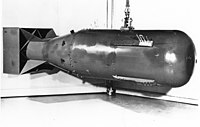
Photo from wikipedia
Coupling of soil‐air temperature is fundamentally relevant to various biophysical and biogeochemical functions near the land surface. However, coupling at an interannual scale is less addressed than at finer timescales,… Click to show full abstract
Coupling of soil‐air temperature is fundamentally relevant to various biophysical and biogeochemical functions near the land surface. However, coupling at an interannual scale is less addressed than at finer timescales, such as diurnal and seasonal scales. Here, we show that interannual variability of soil‐air temperature coupling decreased significantly during 1984–2013 across 196 stations in northern Eurasia. Coupling at a depth of 0.2 m remained significant in only 53% of stations during 1999–2013, while it was significant in 80% of stations during 1984–1998. Decreased coupling is mainly attributable to air temperature change in the snow‐free season and snow cover retreat. Moreover, change in the extreme snow cover frequency also contributes to the decline, while other climate extremes are less influential. The findings can help us to understand long‐term land‐climate thermal interactions and to evaluate soil temperature profiles simulated by land surface models.
Journal Title: Geophysical Research Letters
Year Published: 2021
Link to full text (if available)
Share on Social Media: Sign Up to like & get
recommendations!